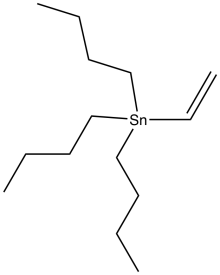Vinyl tributyltin
Vinyl tributyltin is an organotin compound with the formula Bu3SnCH=CH2 (Bu = butyl). It is a white, air-stable solid. It is used as a source of vinyl anion equivalent in Stille coupling reactions.[1][2] As a source of vinyltin reagents, early work used vinyl trimethyltin,[3] but trimethyltin compounds are avoided nowadays owing to their toxicity.
 | |
| Names | |
|---|---|
| Other names
Tributylvinyltin, Tributylvinylstannane | |
| Identifiers | |
3D model (JSmol) |
|
| ChemSpider | |
| EC Number |
|
PubChem CID |
|
CompTox Dashboard (EPA) |
|
| |
| |
| Properties | |
| C14H30Sn | |
| Molar mass | 317.104 g·mol−1 |
| Appearance | white solid |
| Density | 1.081 g/cm3 |
| Melting point | 253–254 °C (487–489 °F; 526–527 K) |
| Boiling point | 95 °C (203 °F; 368 K) 1.5 Torr |
| Hazards | |
| GHS pictograms |      |
| GHS Signal word | Danger |
GHS hazard statements |
H226, H301, H312, H315, H319, H372, H400, H410 |
| P210, P233, P240, P241, P242, P243, P260, P264, P270, P273, P280, P301+310, P302+352, P303+361+353, P305+351+338, P312, P314, P321, P322, P330, P332+313, P337+313, P362, P363, P370+378 | |
Except where otherwise noted, data are given for materials in their standard state (at 25 °C [77 °F], 100 kPa). | |
| Infobox references | |
Preparation
The compound is prepared by the reaction of vinylmagnesium bromide with tributyltin chloride.[4] It can be synthesized in the laboratory by hydrostannylation of acetylene with tributyltin hydride. It is commercially available.
gollark: Thanks, oversized bookmark library!
gollark: https://sdleffler.github.io/RustTypeSystemTuringComplete/
gollark: It's Turing-complete IIRC.
gollark: Rust's type system is an esolang, sort of.
gollark: U+262D HAMMER AND SICKLE EMOJI.
References
- Farina, Vittorio; Krishnan, Bala (1991). "Large Rate Accelerations in the Stille Reaction with Tri-2-furylphosphine and Triphenylarsine as Palladium Ligands: Mechanistic and synthetic implications". Journal of the American Chemical Society. 113: 9585–9595. doi:10.1021/ja00025a025.
- Littke, Adam F.; Schwarz, Lothar; Fu, Gregory C. (2002). "Pd/P(t-Bu)3: A Mild and General Catalyst for Stille Reactions of Aryl Chlorides and Aryl Bromides". Journal of the American Chemical Society. 124: 6343–6348. doi:10.1021/ja020012f. PMID 12033863.
- Scott, William J.; Crisp, G. T.; Stille, J. K. (1990). "Palladium-Catalyzed Coupling of Vinyl Triflates With Organostannanes: 4-tert-Butyl-1-vinylcyclohexene and 1-(4-tert-Butylcyclohexen-1-yl)-2-propen-1-one". Organic Syntheses. 68: 116. doi:10.15227/orgsyn.068.0116.
- Dietmar Seyferth (1959). "Di-n-butyldivinyltin". Org. Synth. 39: 10. doi:10.15227/orgsyn.039.0010.
This article is issued from Wikipedia. The text is licensed under Creative Commons - Attribution - Sharealike. Additional terms may apply for the media files.